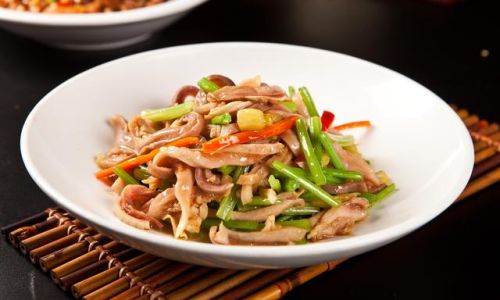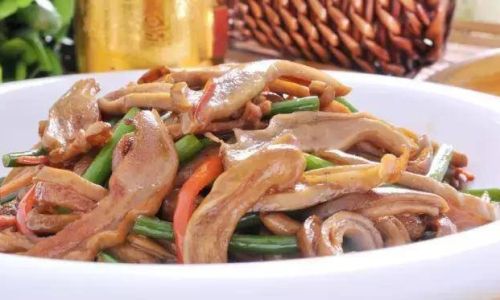Table of content
Crispy pig stomach, known in Chinese cuisine as cuì dù jiān (脆肚尖), is a dish that tantalizes the taste buds with its contrasting textures and bold flavors. The exterior shatters with a satisfying crunch, giving way to tender, flavorful meat inside. While it may sound intimidating to prepare, mastering this dish requires patience, precision, and an understanding of the techniques that transform a humble ingredient into a gourmet experience. This article will guide you through every step of the process, from selecting the freshest ingredients to achieving that coveted crispiness. By the end, you’ll be equipped to recreate this restaurant-quality dish in your own kitchen.
The Allure of Crispy Pig Stomach
Pig stomach, or pork tripe, is a byproduct often overlooked in Western cooking but revered in many Asian cuisines for its unique texture and ability to absorb flavors. When prepared correctly, it becomes a canvas for spicy, savory, or aromatic seasonings. The secret to its appeal lies in the preparation: thorough cleaning, meticulous slicing, and a two-step cooking process that ensures both tenderness and crispiness.
In Chinese culinary traditions, dishes like crispy pig stomach are often served during banquets or family gatherings, symbolizing abundance and the art of transforming humble ingredients into something extraordinary. The dish’s popularity has transcended borders, with food enthusiasts worldwide seeking to replicate its magic. However, achieving the perfect balance of crunch and tenderness demands adherence to specific techniques. Let’s dive into the details.

Ingredients: Quality Matters
Before you begin, gather the following ingredients. Each component plays a crucial role in the dish’s flavor and texture:
- 1 pound fresh pig stomach (pork tripe): Opt for the thickest part, known as the dù jiān (肚尖), which offers the best texture after cooking.
- 2 tablespoons cornstarch: For dredging and creating a light, crispy coating.
- 1 teaspoon baking soda: A tenderizing agent that breaks down tough fibers.
- 1 tablespoon Shaoxing rice wine: Adds aromatic depth and neutralizes any lingering odors.
- 1 tablespoon light soy sauce: For umami-rich seasoning.
- 1 teaspoon white pepper: Enhances the dish’s spicy undertones.
- 4 cups vegetable oil: For deep-frying; ensure it’s neutral to avoid competing flavors.
- 3 garlic cloves, minced: Provides pungent aroma and flavor.
- 2-inch ginger knob, julienned: Adds warmth and complexity.
- 4-5 dried red chilies, or 1 tablespoon chili flakes: Adjust to your spice preference.
- 2 green onions, sliced diagonally: For garnish and freshness.
- 1 tablespoon oyster sauce: Balances flavors with its savory sweetness.
- 1 teaspoon sesame oil: Imparts a nutty finish.
- 1 teaspoon sugar: Counteracts saltiness and enhances caramelization.
- 1 tablespoon Chinese black vinegar (optional): Adds a tangy kick if desired.
Preparation: The Foundation of Flavor
Cleaning the Pig Stomach
Cleaning pig stomach thoroughly is non-negotiable. Follow these steps:
- Rinse under cold water: Remove any visible debris or impurities.
- Scrub with salt and vinegar: Rub the stomach with coarse salt and white vinegar for 5 minutes. This step eliminates odors and slime.
- Blanch in boiling water: Submerge the stomach in a pot of boiling water for 2-3 minutes. Drain and rinse again under cold water.
Slicing Technique
The key to even cooking and maximum crispiness lies in how you slice the stomach:
- Trim excess fat: Remove any visible fat or connective tissue.
- Slice against the grain: Cut the stomach into thin, uniform strips (about 2 inches long and ¼ inch thick). Slicing against the grain ensures tenderness.
Marination
Marinating tenderizes the meat and infuses it with flavor:
- In a bowl, combine the sliced stomach, baking soda, rice wine, soy sauce, and white pepper.
- Mix gently but thoroughly, ensuring each strip is coated.
- Marinate for at least 30 minutes (or up to 2 hours in the refrigerator).
Cooking Process: The Two-Step Fry
Blanching (Optional but Recommended)
Blanching firms up the meat and removes excess marinade:
- Bring a pot of water to a boil.
- Add the marinated stomach and cook for 1 minute.
- Drain immediately and pat dry with paper towels.
First Fry: Low and Slow
This step cooks the meat through and begins the crisping process:

- Heat 2 cups of oil in a wok or deep skillet to 300°F (150°C).
- Dredge the stomach strips in cornstarch, shaking off excess.
- Fry in batches for 2-3 minutes until lightly golden. Avoid overcrowding the pan.
- Remove with a slotted spoon and drain on a wire rack.
Second Fry: High Heat for Crispiness
The final fry at higher heat achieves that shatteringly crisp texture:
- Increase the oil temperature to 375°F (190°C).
- Refry the stomach strips for 1-2 minutes until golden brown and crispy.
- Drain again on a wire rack. This two-step method prevents sogginess.
Sauce Preparation: Balancing Flavors
While the stomach fries, prepare the sauce. The goal is a harmonious blend of spicy, savory, and aromatic elements:
- Heat 2 tablespoons of oil in a clean wok over medium heat.
- Add garlic, ginger, and dried chilies. Stir-fry for 30 seconds until fragrant.
- Stir in oyster sauce, sesame oil, sugar, and black vinegar (if using).
- Mix 1 tablespoon of cornstarch with 2 tablespoons of water to create a slurry. Add to the wok and stir until the sauce thickens slightly.
Final Assembly: Bringing It All Together
Timing is crucial here to maintain crispiness:
- Toss the fried stomach strips in the sauce, ensuring each piece is coated.
- Add green onions and toss briefly to wilt them slightly.
- Transfer to a serving plate and garnish with additional chili flakes or sesame seeds if desired.
Serving Suggestions
Crispy pig stomach is best enjoyed immediately, while the texture is at its peak. Pair it with:
- Steamed jasmine rice: To balance the dish’s richness.
- Pickled vegetables: Their acidity cuts through the fried elements.
- A cold beer or jasmine tea: Enhances the dining experience.
Tips for Perfection
- Temperature Control: Maintain precise oil temperatures during frying. Use a thermometer to avoid burning or greasiness.
- Uniform Slicing: Uneven strips will cook unevenly, leading to some pieces being tough while others are overcooked.
- Don’t Skip Marination: Baking soda is key to tenderizing the stomach; skipping it will result in chewy meat.
- Serve Immediately: The crispiness diminishes quickly, so plate and serve right after cooking.
Variations and Innovations
While the classic recipe is a crowd-pleaser, feel free to experiment:
- Spice Level: Adjust chili quantities or use fresh bird’s eye chilies for extra heat.
- Sweet and Sour Twist: Add pineapple chunks and a splash of rice vinegar for a tangy-sweet profile.
- Vegetarian Adaptation: Substitute the stomach with king oyster mushroom stems, sliced and prepared similarly.
Common Pitfalls and How to Avoid Them
-
Soggy Coating:

- Cause: Overcrowding the pan during frying.
- Fix: Fry in small batches and ensure the oil returns to temperature between batches.
-
Tough Meat:
- Cause: Insufficient marination or slicing with the grain.
- Fix: Marinate for the full 2 hours and always slice against the grain.
-
Bland Flavor:
- Cause: Under-seasoning or rushing the marination.
- Fix: Taste and adjust the sauce before tossing the stomach.
Cultural Context: More Than Just a Dish
In Chinese culinary philosophy, dishes like crispy pig stomach embody the principle of wǔ wèi xiāng hé (五味相和)—the harmony of five flavors. Each component (sweet, salty, sour, bitter, spicy) works in concert to create a balanced taste profile. This dish also reflects the resourcefulness of Chinese cooking, where even offal is elevated to gourmet status through skillful preparation.
Conclusion: The Reward of Patience
Crispy pig stomach is a dish that rewards diligence. From the meticulous cleaning to the precise frying, every step contributes to its allure. While it may seem daunting at first, practice will make the process second nature. Whether you’re cooking for a special occasion or simply craving a textural adventure, this recipe is sure to impress. So, roll up your sleeves, gather your ingredients, and embark on a culinary journey that bridges tradition and innovation. Your taste buds will thank you.
Word Count: 1,959





0 comments